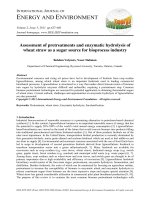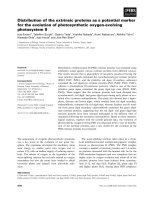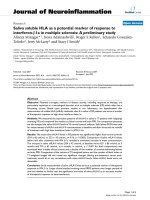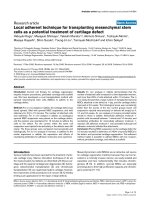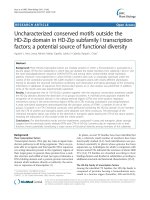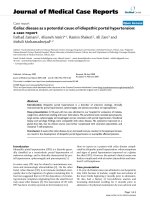Sundry of PGPR as a potential source of plant growth promotion in arid and semi-arid regions
Bạn đang xem bản rút gọn của tài liệu. Xem và tải ngay bản đầy đủ của tài liệu tại đây (156.86 KB, 7 trang )
Int.J.Curr.Microbiol.App.Sci (2018) 7(9): 455-461
International Journal of Current Microbiology and Applied Sciences
ISSN: 2319-7706 Volume 7 Number 09 (2018)
Journal homepage:
Review Article
/>
Sundry of PGPR as a Potential Source of Plant Growth Promotion
in Arid and Semi-Arid Regions
Sapna Gupta*, Ruchi Seth and Anima Sharma
Department of Biotechnology, JECRC University, Jaipur, Rajasthan, India
*Corresponding author
ABSTRACT
Keywords
Biodiversity, PGPR,
Biofertilizers,
Drought
Article Info
Accepted:
06 August 2018
Available Online:
10 September 2018
Arid and semiarid regions are illustrious for stressed atmosphere primarily attributable to
erratic precipitation, low fertility of soil, leading to low crop productivity with high
uncertainty within the field conditions. In arid and semiarid areas all stresses
preponderantly drought limits the expansion and yield of crops significantly inflicting the
foremost fatal economic losses in agriculture. This form of abiotic stress, have an effect on
the plant water relation at cellular and whole plant level, decrease N and C metabolism that
result in modulate plant physiology and chemical process activity. The adaptation
difference mechanism of plant drought tolerance might involve promotion of root
extension, permitting associate economical water uptake. PGPR can serve as successful
eco-friendly tools (Biofertilizers) to implement sustainable agricultural practices in all
parts of the planet. PGPR assist host plant to cope with stresses and build changes in root
morphology. Drought acceptance to the plants are typically elicited by PGPR inoculations
that unit of measurement customized to water restricted soil conditions. Drought tolerance
to the plants is induced by PGPR inoculations that are custom-made to water restricted soil
conditions. PGPR utilizes induced system tolerance (IST) to induce physical and chemical
changes that lead to increased tolerance of plants to abiotic stress. Azospirillum spp.,
isolated from arid areas will develop tolerance level in crop plants below water deficit
condition. PGPR considerably promote seedling emergence, vigor and yield by
competitory with different rhizobacteria through production of antibiotics, lytic catalyst,
chemical compound siderophore and bacteriocin. The treatment of soil by biofertilizers not
only enhances soil fertility but also enriches soil microorganism life. A number of the
foremost established PGPR strains belong to the bacteria genus, Bacillus, Azospirillum,
Azotobacter, Streptomyces, Klebsiella, Enterobacter, Alcaligenes, Arthrobacter,
Flavobacterium, Burkholderia, Bradyrhizobium, Mesorhizobium, Rhodococcus and genus
Serratia.
Introduction
Dry lands cover 6150 million ha, that is,
47.2% of land area. Amongst hyper-arid zones
cover 7.5%, arid zones cover 12.1% of land
area, while semiarid zones are more extensive,
occur in all continents, and cover 17.7% of
land surface. 9.9% of land area covers by the
dry sub-humid environment. In India almost
53.4% land area comprises arid and semi-arid
regions. Arid and semi-arid regions area unit
characterized by a climate with no or
455
Int.J.Curr.Microbiol.App.Sci (2018) 7(9): 455-461
insufficient rainfall, low fertility of the soil,
resulting in low crop productivity with high
uncertainty in the field conditions. In these
regions the rains are erratic and often come in
a few heavy storms of short period leading to
high runoff, rather than replenishing the
bottom water. Protective vegetation cowl is
distributed and there's little moisture for the
most parts of the year. Cultivation in these
regions is confined to limited productive land,
while a large animal population depends on
native vegetation. Chemicals used as
fertilizers for crop improvement in arid and
dry regions have also worsened the condition
of soil by creating them more saline and
barren. Continuous use of chemicals
destabilize the soil ecology, disrupt the
surroundings, degrade soil fertility, and
consequently shows destructive effects on
human health together with contaminating
water and therefore making environmental
hazards. Therefore, there is emerging need to
develop ecologically and environmentally
sound technology for crop plant growth in arid
and semi-arid regions.
known as PGPR (plant growth promoting
rhizobacteria) (Vessey, 2003). PGPR enhance
plant growth with mechanisms such as
phosphate
solubilization,
1aminocyclopropane-1-carboxylate
(ACC)
deaminase
production,
siderophore
production,
quorum
sensing
signal
obstruction, biological nitrogen fixation,
rhizosphere engineering, inhibition of biofilm
formation, antifungal activity, phytohormone
production, etc (Figure 1). In addition, a
number of the PGPR produce volatile organic
compounds, induced systemic resistance,
promote useful plant-microbe symbioses, and
also interfere with toxin production by
pathogenic microbes. The importance of
PGPR in sustainable agriculture has steady
magnified attributable due to the possibility
that PGPR might replace the utilization of
chemical fertilizers, pesticides and different
supplements.
These
rhizosphere
microorganisms
produce
the
growth
promoting substances in huge quantities by
that influence the general morphology of the
plants indirectly.
The rhizosphere of plants is colonized by
complicated and dynamic communities of
microorganisms. The bacterium lodging
around the plant roots (rhizobacteria) area unit
additional
resourceful
in
reworking,
mobilizing, solubilizing the nutrients as
compared to those from bulk soils (Ali et al.,
2010). Therefore, the rhizobacteria area unit
the dominant etymologizing forces in usage
the soil nutrients and consequently, they're
crucial for soil fertility (Glick, 2012). Soilplantrhizobacteria
interactions
area
complicated and there are several within
which the end result will influence the plant
health and productivity.
PGPR functions as elicitors of tolerance to
varied stresses found in arid and semi-arid
regions like drought, salt and nutrient
deficiency. Here, we tend to review PGPRinduced physical and chemical changes in
plants that end in increased tolerance to varied
stresses found in arid and dry regions, and
recently published work associated with this
subject.
Soil microorganism species mushrooming in
plant rhizosphere which raise in, on, or around
plant tissues stimulate plant growth by a
superfluity of mechanisms are collectively
PGPR effects on drought stress
PGPR effects on drought stress are recognized
as a complex constraint limiting the potential
yields of crops. Moisture stress throughout the
crop cycle, accounts for about 30 to 70 % loss
in productivity. In India, as in many other
parts of semi-arid regions of the world, 78%
of the area under rain-fed cultivation and is
inescapably linked to the uneven rainfall
456
Int.J.Curr.Microbiol.App.Sci (2018) 7(9): 455-461
distribution. Out of the overall gross cultivated
space of the country, 56m HA is subjected to
inadequate and extremely variable rainfall. In
Bharat 337 districts as drought prone declared
by National Commission on agriculture.
In arid and semi-arid regions drought stress
limits the expansion and productivity of crops
(4). So that PGPR can be used as a better
alternative. Early studies on IST to drought
(Timmusk and Wagner, 1999), according that
immunisation with the PGPR Paenibacillus
polymyxa increased the drought tolerance of
Arabidopsis thaliana. RNA differential show
on parallel ribonucleic acid preparations from
P. polymyxa treated and untreated plants
unconcealed that template RNA transcriptions
of a drought-response cistron, Early
Responsive to Dehydration (ERD15), were
conjointly increased. Another PGPR strain,
Achromobacter piechaudii ARV8, that
produces 1-aminocyclopropane-1-carboxylate
(ACC) deaminase, bestowed IST to drought
stress in pepper (Capsicum annuum L.) and
tomato (Solanum genus Lycopersicon L.)
plants (Mayak, et al., 2004).
The co-inoculation of bean (Phaseolus
vulgaris L.) with bacteria genus tropici and 2
strains of P. polymyxa was subjected to
drought stress conditions resulting in an
increase in the shoot dry weight, nodule range,
and plant height (Figueiredo, et al., 2008).
Investigations into however drought stress
affects phytohormone balance unconcealed a
rise in abscisic acid (ABA) content within the
leaves, indicating that the reduction of
endogenous plant hormone levels magnifies
ABA content, eliciting stomata closure
(Figueiredo et al., 2008 and Cowan et al.,
1999). The cytokinin ABA antagonism can be
the results of metabolitic interactions as a
result of they share a standard synthesis origin
(Cowan et al., 1999). The cytokinin produced
by P. polymyxa might have a determinable
effect on the ABA signaling of plants or
rhizobia-elicited nodulation (Timmusk and
Wagner, 1999 and Figueiredo, et al., 2008).
Arbuscular mycorrhizal fungi (Glomus
intraradices or G. mosseae) and PGPR
Pseudomonas mendocinawere co-inoculated
in lettuce (Lactuca sativa L.) and increased
AN inhibitor enzyme underneath severe
drought conditions, suggesting that they will
be employed in inoculants to alleviate the
oxidative harm evoked by drought (Kohler, et
al., 2008).
The effects of inoculation of ACC-deaminase
containing PGPR (Pseudomonas fluorescence
169 and Pseudomonas putida 108) on the
yield and some agronomic traits of maize
underneath water shortage stress within the
Mahvelat region of Iran has considerably
increased stem, tassel dry weights, cob weight
and grain yield (Ghanbari, et al., 2013). Seed
bacterization of maize with exopolysaccharide
(EPS) improve soil wetness content, plant
biomass, shoot and root length and leaf area
by using these bacterial strain Proteus penneri
(Pp1), Pseudomonas aeruginosa (Pa2), and
Alcaligenes faecalis (AF3). Plants showed
increase in relative water content protein sugar
though proline content and activities of
antioxidants enzymes were decreased under
drought stress. Consortia of inocula and their
individual EPS showed bigger potential to
drought tolerance compare to PGPR inocula
used alone (Hafsa, et al., 2014).
PGPR effects on salinity stress
Soil salinity in arid regions is usually a vital
limiting reason in cultivating agricultural
crops. Though several technologies are
involved within the improvement of salt
tolerance, solely PGPR-elicited plant tolerance
against salt stress has been antecedently
studied. In another study (Mayak, et al.,
2004), Achromobacter piechaudii was used to
reduce the the gas content in tomato seedlings
457
Int.J.Curr.Microbiol.App.Sci (2018) 7(9): 455-461
exposed to high salt. Thus, implying that
microorganism command deaminase was
practical. In the presence of high salt (66%)
content the tomato seedling inoculated with A.
piechaudii that produces ACC which increases
growth of tomato seedling.
Pseudomonas putida inoculated cotton
seedling showed an enhanced germination
rate, plantheight, fresh weight, dry weight and
healthy cotton stand as compared to control
(CK) plants. Augmentation in the absorption
of the Mg2+, K+ and Ca2+ and reduction in
the uptake of the Na+ from the soil and
improvement in the production of endogenous
IAA content and reduction within the abscisic
acid (ABA) content of cotton underneath salt
stress was reported (Lixia, et al., 2010).
Brachybacterium saurashtrense (JG-06),
Brevibacterium
casei
(JG-08),
and
Haererohalobacter (JG-11) inoculated plants
of A. hypogaea (100mM NaCl) increased all
the physiological parameters like plant length,
shoot length, root length, shoot dry weight,
root dry weight as compared to uninoculated
plants and biochemical (proline and soluble
sugar) factors were considerably lower in
inoculated plants compared to uninoculated
plants (Pushp, et al., 2008).
458
Int.J.Curr.Microbiol.App.Sci (2018) 7(9): 455-461
PGPR increase
uptake
fertility
and
Due to the various environmental problems
and the growing process of fertilizers, there is
a thrust amongst farmers worldwide to reduce
fertilizer use beneath the recommended levels
for paramount yields; however such decline
would pose an abiotic stress on plants.
Therefore, many studies are being carried out
to determine if PGPR can facilitate
agricultural
plants
while
maintaining
productivity and reducing the rate of fertilizer
applications. It was observed in a field study
that the yield for wheat (Triticum aestivum L.)
plants (Shaharoona, et al., 2008) that were
given 75% of the suggested amount of N-P-K
fertilizer and a PGPR strain was like the yield
for plants that were given complete quantity
of fertilizer however while not PGPR.
Another study performed on tomato
(Herna´ndez and Chailloux, 2004) showed
that the dry weights of tomato transplants
grown in greenhouse were considerably
higher with75% fertilizer and 2 PGPR strains
than with the complete quantity of fertilizer
and no PGPR; once transplant to the field,
yields with some mixtures of PGPR and
mycorrhizal fungi at 50% suggested field
fertilization were bigger than the yield of the
100%
fertilizer
management
without
microbes. In Integrated nutrient management
systems of agricultural uses PGPR because
they can help to reduce the buildup of
nutrients in fertilized soils. A three-year field
study on maize (17), was in support of this
technique that evaluated PGPR with and
while not mycorrhizal fungi, manure and
inorganic fertilizer, further like and while not
tillage. Noteworthy increase in grain yield
from microbial treatments were accompanied
by augmented nitrogen content per gram of
grain tissue and removal of significantly
higher amounts of nitrogen, phosphorus and
potassium. Therefore, inside the tested
nutrient
management
system,
PGPR
contributed considerably to reducing nutrient
build up within the soil. Numerous studies are
ongoing that will further describe the utility of
nutrient
Another major issue that affects the plant
growth in arid and semi-arid region is
insufficient availability of soil nutrients.
Although soil fertilization is typically
required for agricultural production but over
fertilization with chemical is availability of
fertilizers that eventually contaminates
surface and ground waters because
accumulation of nitrate and phosphate
components. The environmental impacts of
fertilization are attributed, in part, to low
uptake potency by crops. For example,
phosphorus is very reactive with iron,
aluminum and calcium element present in soil
which can result in precipitation of up to 90%
of the soil phosphorus (Gyaneshwar, et al.,
2002), therefore creating it for the most part
unavailable to plants. PGPR can rise as
promising components in approaches for
maintaining adequate plant nutrition and
reducing the negative environmental effects
of fertilizers. Some PGPR has been related to
the solubilization and increase uptake of
phosphate which helps in plant growth
promotion (Mantelin and Touraine, 2004).
PGPR have additionally been according to
have an effect on nitrate uptake by plants
(Mantelin, Touraine 2004 and Adesemoye, et
al., 2008). Additionally to inflicting will
increase generally plant growth, some PGPR
promote root development (Mantelin and
Touraine, 2004) and alter root design by the
assembly of phytohormones like indole acetic
acid (IAA) (Kloepper, et al., 2007), leading to
increased root area and numbers of root tips.
Such stimulation of roots will aid plant
defense against pathogens and might
additionally relate to induced general
tolerance (IST). As root tips and root surfaces
area unit sites of nutrient uptake, it's possible
that one mechanism by that PGPR cause
enlarged nutrient uptake is via stimulation of
root development.
459
Int.J.Curr.Microbiol.App.Sci (2018) 7(9): 455-461
PGPR in nutrient management methods aimed
at reducing fertilizer application rates and
nutrient runoff from agricultural soils.
Acknowledgement
Some of the research in the present review
has partially been supported by JECRC
University, Jaipur, and Rajasthan. Author
would like to acknowledge Mr. Mohit
Agrawal and Mr. Gaurav Kaushik for
valuable suggestions and guidance.
Perspectives
PGPR will aid the expansion of crops in
environmentally unfavorable conditions.
Many studies on mechanisms by which PGPR
evokes tolerance to specific stress factors
show that they improve the utilization of
PGPR in agriculture by allowing the
microbial mixtures to be optimized for the
assembly
of
specific
microorganism
determinants (e.g. cytokinin, antioxidants,
ACC deaminase, VOCs and IAA).
References
Adesemoye, A.O., Torbert, H.A., and
Kloepper, J.W., 2008. Enhanced plant
nutrient use efficiency with PGPR and
AMF in an integrated nutrient
management system. Can. J. Microbiol.
54(10), 876–886.
Ali, R.S., Amara, U., Khalid, R., and Ahmed,
I. 2010. Soil beneficial bacteria and
their role in plant growth promotion a
review. Ann. Microbiol. 60,579–598.
Cowan, A.K., Cairns, L.P., and Rahm, B.,
1999. Regulation of abscisic acid
metabolism: towards a metabolic basis
for abscisic acid cytokinin antagonism.
J. Exp. Bot. 50(334), 595–603.
Figueiredo, VB., Burity, A., Martinez, R., and
Chanway, P., 2008. Alleviation of
drought stress in the common bean
(Phaseolus vulgaris L.) by coinoculation
with
Paenibacillus
polymyxa and Rhizobium tropici. Appl.
Soil Ecol. 40(1), 182–188.
Ghanbari, Zarmehri, S., Moosavi, S.G.,
Zabihi, H.R., and Seghateslami, M.J.,
2013. The effect of plant growth
promoting rhizobacteria (PGPR) and
zinc fertilizer on forage yield of maize
under water deficit stress conditions.
Technical Journal of Engineering and
Applied Sciences. 5(9), 3281-3290.
Glick, B.R., 2012. Plant Growth-Promoting
Bacteria: Mechanisms and Applications.
Hindawi
Publishing
Corporation,
Scientifica.
Gyaneshwar, P., Kumar, G., Parekh, J., and
Poole, PS., 2002. Role of soil
Improved plant nutrition with PGPR is due to
numerous mechanisms used by PGPR as
defined here. As an example, if multiplied
nutrient content in plants results from
increased nutrient uptake, IST is operable as a
result of physical or chemical changes within
the plant caused by PGPR square measure
ultimately accountable, as because once
PGPR stimulate root development.
However, PGPR might increase nutrient
convenience while not directly moving plants.
Though this may additionally end in larger
nutrient levels in plants, it might not be
explained by IST. Future investigations into
every case wherever PGPR have an effect on
plant nutrition can elucidate this point. The
field of PGPR-elicited ISR should currently
concentrate on two directions. First, a lot of
studies square measure required to
demonstrate that PGPR cause a variety of
crops to be tolerant to varied environmental
stresses.
Furthermore, the studies included the
measures needed for elucidating the signal
transduction pathways resulting from the
treatment of plants with PGPR below stress
conditions. Only then can the complete edges
of PGPR be understood.
460
Int.J.Curr.Microbiol.App.Sci (2018) 7(9): 455-461
microorganisms in improving P
nutrition of plants. Plant Soil. 245(1),
83–93.
Hafsa, Naseema, Asghari and Banoa., 2014.
Role of plant growth promoting
rhizobacteria
and
their
exopolysaccharide in drought tolerance
of maize. Journal of Plant Interactions.
9(1), 259-265.
Herna´ndez, M., and Chailloux, M., 2004. Las
microrizasarbusculares y las bacteria
rizosfe´ricascomo alternative a la
nutricio´n mineral deltomate. Cultivos
Tropicale. 25(1), 5–16.
Kloepper J.W, Gutierrez-Estrada A, Mclroy
J.A. 2007. Photoperiod regulates
elicitation of growth promotion but not
induced resistance by plant growthpromoting rhizobacteria. Can. J.
Microbiol. 53(2), 159–167.
Kohler, J., Hernandez, J.S., Caravaca, F., and
Roldan, A., 2008. Plant-growthpromoting rhizobacteria and Arbuscular
mycorrhizal fungi modify alleviation
biochemical mechanisms in waterstressed plants. Funct. Plant Biol. 35(2),
141–151.
Kramer, P.J., and Boyer, J.S., 1995. Water
Relations of Plants and Soils. American
Press.
Lixia, Yao, Zhansheng, W.U., Yuanyuan,
Zheng, Imdad, Kaleem, and Chun Li.,
2010. Growth promotion and protection
against salt stress by Pseudomonas
putida Rs-198 on cotton. European
Journal of Soil Biology. 46(1), 49–54.
Mantelin, S, and Touraine, B., 2004. Plant
growth-promoting bacteria and nitrate
availability
impacts
on
root
development and nitrate uptake. J. Exp.
Bot. 55(394), 27–34.
Mayak, S., Tirosh, T., and Glick, BR., 2004.
Plant growth-promoting bacteria confer
resistance in tomato plants to salt stress.
Plant Physiol. Biochem. 42(6), 565–
572.
Mayak, S., Tsipora, T., and Bernar G.R.,
2004. Plant growth-promoting bacteria
that confer resistance to water stress in
tomatoes and peppers. Plant Sci. 166(2),
525–530.
Pushp, S.S., Pradeep, K.A., Bhavanath Jha,
Z.A.,
2008.
Fertilizer-dependent
efficiency of pseudomonads for
improving growth, yield, and nutrient
use efficiency of wheat (Triticum
aestivum
L).
Appl.
Microbiol.
Biotechnol. 79(1), 147–155.
Shaharoona, B., Naveed, M., Arshad, M., and
Zahir, Z.A., 2008. Fertilizer-dependent
efficiency of Pseudomonads for
improving growth, yield, and nutrient
use efficiency of wheat (Triticum
aestivum
L.).
Appl.
Microbiol.
Biotechnol. 79, 147–155.
Timmusk, S., and Wagner, G.H., 1999. The
plant-growth-promoting rhizobacterium
Paenibacillus
polymyxa
induces
changes in Arabidopsis thaliana gene
expression: a possible connection
between biotic and abiotic stress
responses. Mol. Plant Microbe Interact.
12(11), 951–959.
Vessey, J.K., 2003. Plant growth promoting
rhizobacteria as biofertilizers. Plant
Soil. 255, 571–58.
How to cite this article:
Sapna Gupta, Ruchi Seth and Anima Sharma. 2018. Sundry of PGPR as a Potential Source of
Plant Growth Promotion in Arid and Semi-Arid Regions. Int.J.Curr.Microbiol.App.Sci. 7(09):
455-461. doi: />
461

